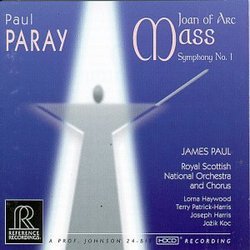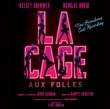| All Artists: Paul, J:cnd/Royal Scottish NO Title: Paray: Symphony No.1 In C/Mass For The 500th Anniversary Of The Death Of Joan Of Arc Members Wishing: 0 Total Copies: 0 Label: Reference Records Original Release Date: 1/1/2000 Re-Release Date: 8/19/1997 Album Type: Enhanced Genre: Classical Styles: Opera & Classical Vocal, Symphonies Number of Discs: 1 SwapaCD Credits: 1 UPC: 030911107826 |
Search - Paul, J:cnd/Royal Scottish NO :: Paray: Symphony No.1 In C/Mass For The 500th Anniversary Of The Death Of Joan Of Arc
 | Paul, J:cnd/Royal Scottish NO Paray: Symphony No.1 In C/Mass For The 500th Anniversary Of The Death Of Joan Of Arc Genre: Classical
|
Larger Image |
CD DetailsSimilar CDs |
CD ReviewsBuy it, but it's not exactly what it could have been Mark McCue | Denver, CO USA | 03/30/1999 (3 out of 5 stars) "If you want Paray's Mass, get his own recording on Mercury (you also get his extraordinary Saint Saens 3rd and his own voice thanking the Mass's performers on the other side). The maestro's own recordings progress with the types of tempo changes and singing inherent with the liturgical functions of a Catholic Mass. Paul's is by comparison a concert runthrough, and everyone's Latin is kind of a clipped Brit stiff-upper-lip schoolbook parlance.The Symphony No. 1 here is given a clear, well-focused reading, interpretatively an appropriate straight-shot. The problem is the unidiomatic orchestra, especially winds, which can't display the compositional voicings a Frenchman like Paray obviously heard in his head. On the old Carthagene vinyl disc (beautifully recorded with the French National Orchestra giving its all) the lush sonorities of string and brass pile up but the winds are ovelaid like jewels on a platinum setting, and the old man himself, wishing to make less of a point, pulls out the stops and moves the thing along. It's a wonderful piece, revealing more detail every time you listen to it. The current account doesn't do that. It's there, you realize it's a good piece, but you feel there's a lot more inherent in it than you get to hear.That old Carthagene disc icluded another composer-led performance of the Mass. The vocal quartet is preferable to the Mercury and the chorus far outsings its Rackham Choir and the Scots in the new version.But if you can't find the Carthagene and want Paray's symphony, you'll have to buy this. However, it's no more than what you'll hear on your first listen. And, after all, since you're going to buy Paray's SS3 anyway, why not try hunting for the Carthagene?" The conductor as composer Evan Wilson | Cambridge, MA | 11/29/2001 (4 out of 5 stars) "OK, you've seen other pieces by conductors and you're not sure what to expect. Sure, Bernstein was a pretty good composer as well as a great conductor, but Furtwangler couldn't compose his way out of a paper bag. What to expect from French conductor Paul Paray?Well, the answer depends on which piece you listen to on this disc. If you listened to the symphony, you might think Paray should have stayed in front of the orchestra. If you listen to the Mass, you might be wondering what other treasures he composed.We'll start the symphony. The other reviewer here suggests that the performance and orchestra prevent the listener from hearing what a terrific piece this is. I dissent. It's not an awful, unlistenable piece by any means. However, it's rather undistinguished melodically and the orchestration is rather stock French (ala Roussel among others) emphasizing the winds. It lacks the panache one finds in Milhaud's best music or the sudden tenderness that appears in Poulenc. Perhaps a quicker performance might cover up its warts, but I still think you'll probably pass over it to listen to the Mass on most occasions.The Mass for the 500th Anniversary of the Death of Joan of Arc is far more memorable, although it's much less French than the symphony. Melodically, much of it (& especially the quieter bits) reminds me of the Requiem by John Rutter (written much later) combined with other English influences (esp. Vaughan Williams). There is an ever-so-slightly saccharine quality to some of the themes which isn't unappealing because there is enough variety to prevent them from growing wearisome. Where Paray parts from Rutter is in the orchestration. Paray uses a much larger orchestra with the brass employed spectacularly at certain points (especially in the Sanctus). Still, the orchestration has few of the French qualities found in the symphony because the brass are more prominent than the woodwinds. Overall, it's not a terribly "devotional" mass, but it is a wonderfully listenable piece with memorable themes and some overwhelming moments. Although I haven't heard Paray's version, the other reviewer here is far to critical of this performance. Where he finds clipped "English" choral singing, I find a rich but clear choral sound that brings out the emotion in the music without creating the sense of leadenness that sometimes occurs with oversized choruses. (In fact, the sound is a major plus here...rich but detailed.) The four soloists sing with focus and appear to enjoy themselves and conductor Paul clearly loves the piece.Overall, if you can find Paray's recording, that is probably the place to start, particularly since it's cheaper. However, given the fact that Mercury's sound can be very harsh, you won't go wrong by picking up this version. And I guarantee, if you like the Rutter Requiem, you'll love this." It's still a three-star Mark McCue | Denver | 12/19/2001 (3 out of 5 stars) "Critical standard in non-standard repetoire naturally expects considerations of aesthetic contexts, and in that my previous report of this disk was amiss.So: the Paray symphony draws from the Gallican traditions of Dukas, Chausson, Franck, Magnard, even Albert and Schmitt, in short, an earlier age, with even some Berliozian brass thrown in for good measure (a fortuitous measure). Already 52 and conductor at the Colonne, Paray was drawing on the last resources of French Romanticism.Berlioz figures in the Mass, too, as would the aforementioned Magnard and possibly evena little Gounod and Duparc. These were Paray's milieu, his aesthetic mentors from when he won the Prix de Rome in 1911.With that, I find the other reviewer here very wide of the mark when he drags Roussel, Milhaud, and Rutter--even more peripheral--into the discussion, as does the conductor James Paul, who as a Paray devotee should have known better. In his interviews,Paul talks about the characteristic Paray glow and section "breath" or sound he always admired as a youth, and yet gives the listener none of it in his performances here, though as Le Mousnier says in his bio of Paray, no one really knows what exactly it was that Paray did to convey his aesthetic, and it will remain a great and admirable mystery.The choice of recording these works with these forces could be appreciated as a stopgap if the thoroughly beautiful composer-led performances hadn't been brought out of ORTF vaults. Rather than sink your bucks here, I suggest you hang onto your turntable and have a broker run down the Carthagene vinyl I suggest.Only then will these works, the symphony in particular, open up for you. It will seem to you that Vincent D'Indy had finished out some sketches and Magnard wrote a few more symphonies after he was shot dead by the Germans as they closed in on his villa.This is still a 3-star, and a queasy one at that."
|

 Track Listings (9) - Disc #1
Track Listings (9) - Disc #1
